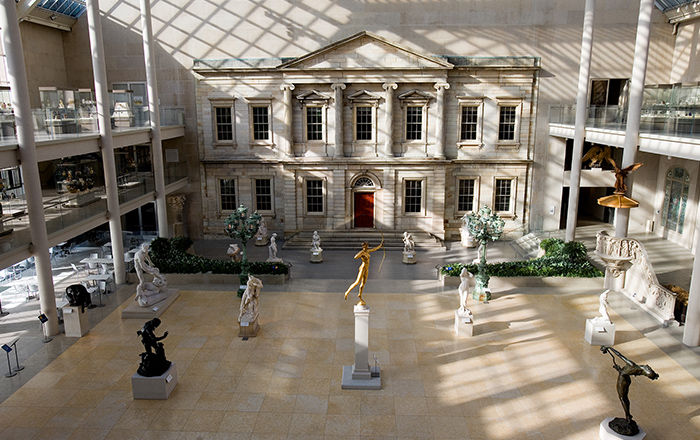Sampler
Hannah B. Loring American
Family record samplers like this one, which recorded the births, and sometimes deaths of members of a single family, are a distinctive American embroidery tradition. The form first appears in New England in the early nineteenth century and reached the height of its popularity between 1810 and 1830. This was an era when the nuclear family coalesced, and young girls stitched decorative genealogical samplers as a mark of accomplishment, social position, and family pride.
The design of Hannah Loring’s elaborate family record was probably inspired by a print, as a slightly later Massachusetts family record done in watercolor by a J. Forbes (in the collection of The New Hampshire Historical Society) is almost identical in format. Both the needlework and the watercolor feature a pair of fluted columns surmounted by an arch with a clock at the center of the arch, connoting the passing of time. Under the arch is written “THE FAMILY” in large letters. Each has a plinth across the bottom upon which there is a mourning vignette with a classical urn surrounded by weeping willows. Hannah’s needlework goes a step further with the mourning iconography, since a mourning drape appears on her arch.
Under the arch, between the pillars, Hannah recorded the name of her father, Mathew (1751-1820) and three of his four wives, with the dates of their births and marriages, as well as the minister who presided over the marriage ceremonies. Below the parents are the names and birth dates of Hannah and eight of her siblings, from Sarah who was born in 1787 to Francis born in 1811. Born on October 22, 1800, Hannah was the only child from her father’s marriage to Sarah Blake Loring (1763-1800), who died at age thirty-seven of complications of childbirth eight days after Hannah was born. In a square panel in the center of the plinth, Hannah’s mother’s death date is inscribed in tiny painted letters along with several other Loring family death dates. On either side of that memorial panel, there are two circular areas that include painted verses, one about “the duty of parents in bringing up their children,” and the other explaining “the duty of children towards parents.” Along the bottom of the sampler, Hannah inscribed “Wrought by Hannah Loring ag’d 12/At Miss Perkins Academy Boston/1812.” Unfortunately, no information about Miss Perkins Academy has yet come to light.
Mathew Loring, Hannah’s father, was a member of the fifth generation of the Loring family in the American colonies. He participated in the Boston Tea Party and served the Revolutionary cause in various capacities during the war. After independence was won, he worked as a cordwainer (shoemaker) in Boston. His first wife, Nancy, died in 1798 and he married Hannah’s mother, Sarah Blake on June 17th, 1799. After her death on October 30, 1800, Mathew married Mercy Bates the following year. After the sampler was completed, Mercy Bates also passed away, and contemporary documents record that Matthew Loring married a fourth time and had another child from that marriage.
When Hannah was twenty-four years old, she married Theodore Abbott (1801-1864), a Boston bookbinder, on November 24th, 1824. The couple had eight children between 1826 and 1850, the youngest of whom was born when Hannah was fifty years old. After the death of her husband on May 19, 1864, Hannah remained in Boston and the 1865 Massachusetts Census records that she lived with two of her daughters, Caroline and Georgianna. When she died on November 28, 1868, Hannah was living at 102 Canton Street in Boston’s South End. She is buried beside her husband at Boston’s Granary Burying Ground.
This image cannot be enlarged, viewed at full screen, or downloaded.

